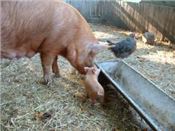|
Illinois, China Study Nutritional Value Of Wheat Bran For Pigs

URBANA, ILL.
Research conducted by the University of Illinois is helping determine the nutritional value of wheat bran in diets fed to pigs. Wheat bran, like many other co-products from the human food industries, contains more fiber than corn and soybean meal, which adversely affects energy digestibility.
“To save on feed costs, more producers are turning to co-products,” says Hans H. Stein, professor of animal sciences at Illinois. “Therefore, there is a need to determine the energy contribution from fiber-rich ingredients. But the effect of dietary fiber on heat production and net energy of diets is unclear.”
In collaboration with colleagues at China Agricultural University (CAU) in Beijing, China, the research was conducted in the calorimetry unit at CAU. Growing barrows were fed diets containing 0, 15, or 30 percent wheat bran. The pigs were housed in metabolism crates inside calorimetry chambers built to measure gas exchange and heat production.
The digestible energy (DE), metabolizable energy (ME), and net energy (NE) in the diets declined as more wheat bran was included. The DE content of diets containing no wheat bran was 3,454 kcal/kg, compared with 3,161 kcal/kg in diets containing 30 percent wheat bran. The ME content of the diets decreased from 3,400 to 3,091 kcal/kg, and NE content decreased from 1,808 to 1,458 kcal/kg.
The research also validated a procedure commonly used to determine NE. Using the difference procedure, Stein's team determined the DE, ME, and NE of wheat bran to be 2,168, 2,117, and 896 kcal/kg, respectively. These values were similar to those derived using a regression procedure.
Stein says that DE and ME are usually determined using the difference procedure, but NE is usually determined using regression equations. As far as he knows, nobody has compared values derived from the difference procedure with values derived via regression.
“Because experiments to determine NE via the difference procedure are more difficult to conduct than determining DE and ME, it’s helpful to know that using regression to determine NE will yield an accurate value,” Stein concludes.
The paper, “Wheat bran reduces concentrations of digestible, metabolizable, and net energy in diets fed to pigs, but energy values in wheat bran determined by the difference procedure are not different from values estimated from a linear regression procedure,” is published in the July 2016 issue of the Journal of Animal Science. It was co-authored by Neil Jaworski of the University of Illinois, and Dewen Liu and Defa Li of China Agricultural University in Beijing. The full text is available online at https://www.animalsciencepublications.org/publications/jas/articles/94/7/3012 . ∆
|
|